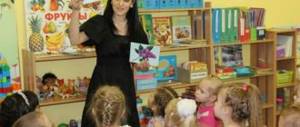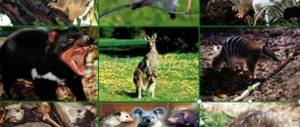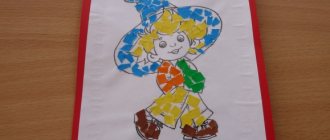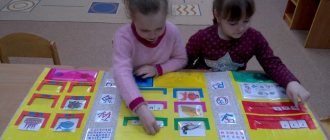Goals and objectives of analyzing classes in preschool educational institutions
Monitoring of classes in preschool educational institutions can be carried out in two types:
- introspection, or reflective analysis;
- analysis by those present, or problematic, which is carried out by colleagues, methodologists, and the management of the preschool educational institution.
This is interesting. Analysis of classes in the senior and preparatory groups can be carried out by primary school teachers who will work with children in grades 1–4. In this case, the purpose of attending the lesson will be to assess the level of preparation of children for school.
Self-analysis is carried out by the teacher in order to identify methodological shortcomings, organizational miscalculations, as well as determine the level of children’s mastery of the curriculum.
Analysis of the lesson allows you to see methodological and organizational failures in the work of the teacher
Problem analysis is designed to diagnose:
- the quality of implementation of the educational program that determines the principles of operation of a particular kindergarten;
- the effectiveness of the methods used to work with children;
- the level of professional skill of the teacher in selecting material and presenting it using techniques for interacting with children;
- compliance of the level of knowledge, skills and abilities of preschoolers with the accepted requirements designated by the Federal State Educational Standard.
The objectives of diagnosing classes in kindergarten are:
- assessment of the accuracy and realism of the lesson goal (that is, the relationship between the time for implementation and the level of preparedness of the kids, their abilities and capabilities);
- tracking the integration of different areas of education within one lesson (that is, fulfilling one of the main requirements of the Federal State Educational Standard, based on combining types of activities from different areas of education - drawing in mathematics, or counting in physical education);
- psychological validity of the content of the material and the form of the lesson (implementation of an integrated approach to choosing a topic through different types of interaction based on the joint activities of children and the teacher - games, conversations, etc.);
- monitoring the progress of the lesson (evaluating both the content of the selection of material and organizational aspects, such as motivating children to work, maintaining interest throughout the lesson, summing up);
- the level of children’s mastery of the material;
- methodological literacy of the teacher (creating a situation of success for each child in the classroom, implementing an individual approach, that is, the ability to both see and “feel” each student).
How to analyze an open lesson in a preschool educational institution according to the Federal State Educational Standard?
Analysis is an important process, which is also regulated.
Setting the goals of the analysis
The main purpose of holding an open event in a preschool educational institution is to demonstrate the pedagogical skills of a competent employee (educator) in the educational field. During the analysis of the role-playing game in the middle group, the preschool teacher must demonstrate the techniques that he uses in his work to achieve the goals of the educational process. In addition, these events are designed to clearly show the successes of the kids.
Activities are important in preschool educational institutions
Objectives of the analysis conducted in an open format:
- Assessment of its development and preparedness.
- Assessing the level of preparedness of children for the transition to a new educational level.
- Analysis of the structure of the lesson.
- An assessment of the educational techniques that were used at the event.
- Assessing how competently and effectively the teacher interacted with his students.
- Identification of existing deficiencies in implementation, identification of opportunities to eliminate them.
You need to analyze your activities
What kind of analysis is there?
The Federal State Educational Standard assumes that, following the results of any educational event, a preschool teacher conducts an analysis of exemplary and variable preschool education programs, in which the successful and unsuccessful aspects of the hour spent are highlighted.
For your information! To put it simply, the format of self-analysis looks like this: “it worked - it didn’t work.”
The analysis of an open lesson should be more detailed; this type of analysis involves the involvement of third-party cultural specialists.
Introspection
Self-analysis is the analysis of one's own results. Naturally, such a process may be characterized by a high degree of subjectivity.
Goals of self-analysis:
- highlighting successful stages;
- correlation of actual results with desired ones;
- assessment of the mood and emotional background of pupils.
Analysis of colleagues (analysis of those present)
Analysis of those present allows us to provide a more objective picture of the lesson. Analysis of colleagues, in turn, is one of the directions of such an event. Colleagues working in kindergartens have the necessary level of competencies to evaluate educational activities from a professional point of view and provide routine methodological recommendations for improvement.
For your information! The non-professionals present are able to give an outside picture, highlight advantages and disadvantages, and point out those aspects that need to be improved.
Those present should also evaluate the teacher
Brief outline of self-analysis
The Federal State Educational Standard provides for a certain procedure (algorithm, map) for conducting self-analysis:
- The number of children currently present at the event is recorded, and their age group is determined (junior, preparatory, senior).
- The main goals, objectives and theme are determined.
- The actual structure of the GCD is described in detail.
- Physical (outdoor games, the opportunity to visit a sports corner) and psychological (comparative analysis, speech) techniques used during it are analyzed, and their analysis must be detailed (the materials and equipment used are indicated).
- The level of organization and effectiveness of the content and form of FEMP is assessed . These include the logic of presentation of the material, rhythm, tempo, emotional coloring, the degree of involvement of the children during the hour, as well as how actively they work and how capable they are of independent action.
- The negative aspects of the event are highlighted.
- Methods for eliminating identified deficiencies or awarding a certificate are proposed.
Planning a theater week in preparatory groups of preschool educational institutions
Analysis scheme
It should be understood that the Federal State Educational Standard provides for a certain methodology for conducting the corresponding analysis.
Algorithm for conducting analysis by those present
Analysis of the GCD by outside observers is carried out in several stages:
- Determining student readiness. An assessment is made of how competently the teacher explained the fact of the presence of strangers, as well as an assessment of the level of children’s motivation for further actions.
- Checking the compliance of the stated purpose of the lesson with its actual content (fullness).
- Assessing the effectiveness of the level of organization of students. You should pay attention to how the cognitive activity of children is stimulated, at what pace the work is carried out, how much children maintain attention, and how the risk of premature fatigue is overcome.
- Analysis of the course of the lesson. It is necessary to assess how appropriately the time is distributed between the various types of work offered to the children to perform during the NOD.
- Assessment of the structure of the NDA in general and its components in particular.
- Analysis of methods for stimulating children to control and evaluate.
- Overall assessment of the lesson.
The teacher can be assessed based on the children’s mood
Example of self-analysis of a lesson
Despite the presence of a certain algorithm for conducting self-analysis, its result more often resembles an emotional narrative. The self-analysis should cover the following:
- topic of the lesson;
- age and group of pupils;
- characteristics of the group;
- characteristics of the lesson (is it complex, what educational areas does it include);
- intended goals and objectives;
- presence of gaming motivation;
- description of the course of the lesson;
- characteristics of the emotional background;
- techniques used during the event;
- connectivity of stages;
- materials and methods used;
- special comments (whether the children’s activity and motivation increased);
- compliance of the duration of the lesson with SanPiN standards;
- personal assessment of the achievement of set goals and objectives;
- positive impressions from the lesson;
- negative impressions;
- results of a survey of children about their impressions.
Group analysis (example)
The results of group analysis are usually presented in a certain form.
The first block “General Information” presents the following parameters:
- age of pupils;
- teacher's name;
- area of occupation;
- subject;
- target;
- tasks (educational, developmental, educational);
- duration of the GCD;
- the degree of fulfillment of set goals and objectives;
- compliance of the goals and content of the NOD with the real capabilities of the children;
- assessment of interaction between students and teacher.
The teacher must be assessed adequately
The second block is called “Observing the flow of the GCD”:
- clarity and accessibility of disclosure of goals;
- assessment of work - organization, content, completion;
- assessing children's interest and involvement;
- determination of the skills acquired by the children during the educational training;
- description of the skills demonstrated by the kids during the lesson.
Theater clubs for children: skits, plays and lesson programs
The third block is “Methods and techniques used during the lesson”:
- identification of methods and techniques used;
- characteristics of transitions, the logic of the activity, the feasibility of changing activities;
- identification of equipment used.
The fourth block is “Analysis of the activities of a preschool educational institution employee”:
- characteristics of the teacher's behavior;
- level of iteration of children and teacher;
- taking into account the individual characteristics of pupils;
- compliance with rules, procedures, safety precautions.
The fifth block represents the issuance of recommendations and identification of comments.
Analysis techniques
To monitor a lesson, three types of techniques are used.
Verbal techniques
Analysis of a lesson involves an oral presentation in the form of a report at a teachers' council (small if the analysis is carried out immediately after the lesson, or large if monitoring is part of the development of a methodological problem by a senior educator about the progress of work in a preschool educational institution). With the exception of cases when, when conducting competitions of pedagogical skills, the teacher is required to compile a methodological folder, including, among other things, several written self-analysis of classes. In general, the completed tables according to the analysis criteria are presented orally.
An oral presentation of the analysis is made on the basis of the monitoring map
Observation
This is the main way to obtain data for analysis. With the help of observation, a person analyzing the organization of direct educational activities (DEA) makes a conclusion about:
- the methodological equipment of the lesson, that is, the correspondence of the set of visuals to the topic, the level of the children (for the first junior group, an illustration about spring with flying birds and melted snow is quite enough, but pictures with the sowing of garden and cereal crops will be superfluous);
- psychological climate in the lesson (for example, does the teacher find the “key” to all children, including hyperactive, inattentive ones; for example, in the older group such children can be involved in reading poems or riddles that illustrate the topic);
- methodological knowledge of the teacher, that is, how the teacher varies the methods of interaction with the children depending on the complexity of the material, the experience of the children or their general physical condition (for example, in a lesson on speech development after a physical education lesson, you should not give children an outdoor game as a physical education lesson, it is better limit yourself to finger gymnastics).
Practical techniques for analyzing lesson notes
It is understood that before attending a lesson, the psychological and pedagogical characteristics of the children in the group and self-analysis of the types of direct educational activities will be studied. After the lesson, the teacher provides the inspector with a summary of the lesson, which is considered not only from the point of view of the selected materials for work, techniques, but also from the point of view of the correct execution of such documents (indication of the topic, goals, objectives, description of the course of the lesson, expected results).
This is interesting. Indicating the expected results in the lesson notes allows the examiner to adequately evaluate the techniques chosen for interaction in the lesson. For example, if one of the expected results was memorizing a new rhyme, then this fully justifies the fact that the poem in class was repeated 2-3 times at all stages of the lesson, and not just once in the introductory part, which is enough to get acquainted with the topic.
Analysis of the notes allows you to see the consistency of the structure of the lesson and the consistency in the choice of methodological techniques for developing a specific topic
Preparation and conduct of open demonstrations of educational activities in preschool educational institutions
Preparation and conduct of open demonstrations of continuous educational activities in preschool educational institutions
Open demonstrations of continuous educational activities play an important role in the system of advanced training for teachers and the educational process in general. They allow teachers to see how colleagues work, use their positive experience, and realize their shortcomings. The effectiveness of this form of work largely depends on its correct preliminary preparation.
There are a number of requirements for preparing and conducting open demonstrations of continuous educational activities with preschool children.
Attention
It should be taken into account that an open demonstration of continuous educational activities, in contrast to ordinary continuous educational activities with children, is a specially prepared form of organizing methodological work, during which the main directions of the educational process of a preschool educational organization (hereinafter referred to as the preschool educational institution) are implemented. At an open demonstration of continuous educational activities, the teacher demonstrates to colleagues his positive or innovative experience in implementing a methodological idea and using a specific teaching technique or method.
Thus, an open demonstration should be conducted by teachers who have a high level of scientific and methodological training and ensure high efficiency of the educational process.
Such continuous educational activities with children should become a source of innovative experience and address current problems of methodological science in the field of preschool pedagogy and psychology and have novelty. Novelty may relate to the content of didactic material or methods of studying it.
Attention
Showing continuous educational activities with children, in which a widely used methodology is implemented in practice, will not contribute to the professional growth of other teachers. However, in methodological work with young teachers, this limitation does not always need to be taken into account, since for them even traditional, well-known methods are of some interest.
As a form of organizing the educational process, open display of continuous educational activities must contain a new, special structure. It may reflect the solution to a methodological problem, a topic of self-education that the teacher is working on. The individual methodological theme of the teacher is associated with the general methodological problem of the preschool educational institution team.
In addition, the teacher must prepare theoretical and visual material, multimedia, equipment, organize space, etc.
Open demonstrations of continuous educational activities are held without “rehearsal” under normal conditions, with generally accepted duration, without violating the requirements for the educational process. The day before, it is recommended to inform children and their parents (legal representatives) about the upcoming activity. This will prepare students for the situation of the presence of strangers.
The presence of strangers in the room should not distract children or create discomfort. Work places must be prepared for visitors, which are located behind the backs of preschoolers so that guests do not distract them. The visitor cannot be seated next to the child, on the side. The number of invitees should be limited.
Observations show that the attendance of such events by at least one stranger creates inconvenience for both the teacher and the children, and therefore it is now widely practiced to study the experience of teachers by video recording their professional activities.
Open demonstrations of continuous educational activities are held in accordance with the methodological work plan of the preschool educational institution. Teachers must have sufficient time to prepare it.
Advice
You should not hold several open screenings in one group on the same day, or organize them in the same group several times a month. This is explained by the great psychological stress that children and teachers experience.
An open display of continuous educational activities is being built taking into account didactic goals: teaching, educational, developmental and additional motivational. During this activity, children should gain as much knowledge as they would have learned by studying this topic under normal conditions.
Attention
It is unacceptable to explain only that part of the topic that allows you to most clearly demonstrate a new methodological technique, leaving other aspects for the next event or transferring them to another activity.
An open display of continuous educational activities should not contradict the programs under which the teacher and the preschool educational institution as a whole work. Notes of all open screenings are prepared and stored in the methodological office.
When preparing for an open demonstration of continuous educational activities, the teacher needs to make a forecast of expected results and expected risks.
Thus, a methodologically competent organization of open viewings of children's activities will contribute to the continuous improvement of a teacher's qualifications in a preschool educational institution, his understanding of advanced pedagogical experience at a higher theoretical and practical level, and the improvement of his professional skills.
What types of activities are analyzed
Monitoring is carried out in open or ongoing classes, regardless of their educational focus:
- speech development;
- formation of elementary mathematical concepts (FEMP);
- formation of a holistic picture of the world (FCCM);
- music activity;
- speech therapy session;
- choreography;
- physical training;
- basics of literacy.
This is interesting. Schemes for analyzing physical education and choreography will differ in content from diagnostics in other classes.
In addition, it is mandatory to conduct an analysis of educational activities as part of:
- walks;
- matinee;
- entertainment.
This is interesting. If in classes of direct educational activities, special emphasis in the analysis is placed on the organization of cognitive activity (for example, conducting a didactic game) and physical development, then in the diagnosis of matinees and entertainment, an important element of analysis is social and communicative activity.
According to the Federal State Educational Standard, not only activities are analyzed, but also entertainment and walks






